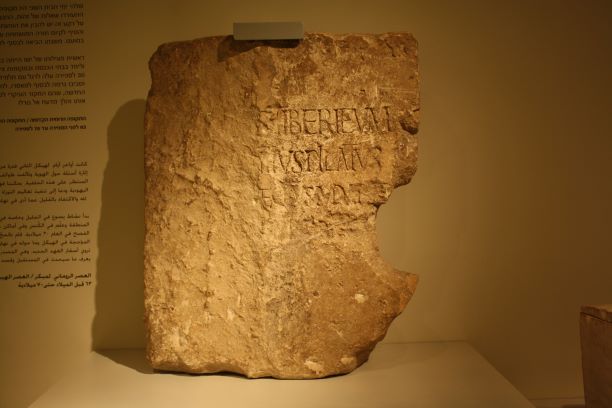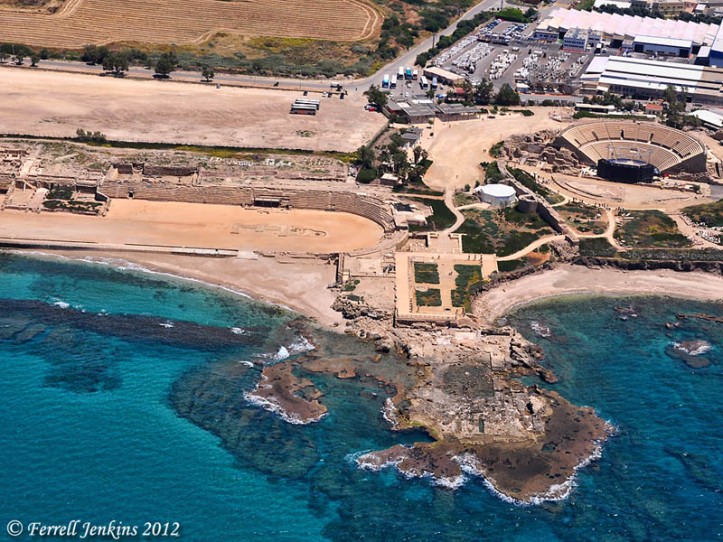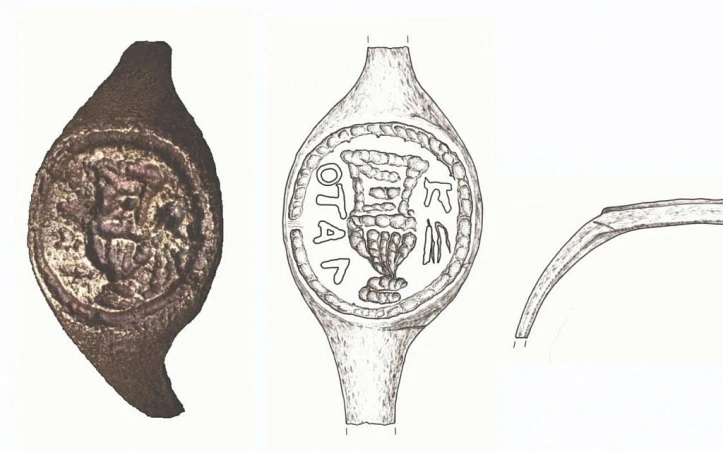
Archaeology tells a story, but it does so piece-by-piece. Sometimes artifacts tell a general story, helping us understand a certain culture in greater detail. Sometimes a discovery tells a specific story, providing information about certain aspects of a person’s life. Such is the case with the subject of our next archaeological biography. In this article we’ll explore the life of Pontius Pilate.
Ancient Writings
Pontius Pilate ruled as the Roman Prefect of Judea from 26-36 AD. Numerous ancient texts provide information about him, including the New Testament gospels, Philo’s On the Embassy to Gaius, Josephus’ Antiquities of the Jews and The Jewish Wars, as well as The Annals, by Tacitus.
The Jewish philosopher, Philo, provides the earliest, surviving written account (ca. 41 AD). He describes Pontius Pilate as one of the “emperor’s lieutenants,” who was “a man of a very inflexible disposition, and very merciless as well as very obstinate.” In Philo’s opinion, Pilate was “exceedingly angry, and…at all times a man of most ferocious passions” who had a habit of insulting others cruelly, and murdering people “untried and uncondemned.”1
The New Testament gospels, written in the middle-to-the-end of the first century, add to our knowledge of Pontius Pilate. His cruelty is mentioned by Luke, who records an account of Pilate mixing the blood of Galileans with their sacrifices (Lk 13:1). Both Luke and Matthew refer to Pilate as the governor, using the Greek word, hēgemōn, which is a general word referring to a leader of any kind. Of course, Pilate is infamous for condemning Jesus of Nazareth to death by crucifixion, as recorded in each of the gospels.

The Jewish historian, Josephus, says that Pilate was “sent by Tiberius as prefect to Judaea”2 and that he condemned Jesus “to the cross.”3 The Roman historian, Tacitus, records how “Christus…suffered the extreme penalty during the reign of Tiberius at the hands of one of our procurators, Pontius Pilatus.”4
Both Philo and Josephus record numerous incidents in which Pilate offended the Jewish people with both his cruelty and his insensitivity to their religious beliefs and how he relented when they threatened to go to Caesar.5 Josephus records an incident in which Pilate used sacred money from the Temple treasury to build an aqueduct to bring water into the city. When many Jews protested, he had them beaten by his soldiers, resulting in many deaths.6
These ancient texts paint a picture of a cruel man who attempted to impose the Roman peace on Judea with an iron fist. He was also self-seeking, and attempted to keep reputation in good standing with the Roman Emperor, Tiberius.
The Pilate Stone

Archaeological evidence for Pontius Pilate was discovered in 1961, when an inscribed stone was unearthed in excavations near the theater at Caesarea Maritima. The limestone block was originally part of a dedication to Tiberius Caesar, although the stone had been reused as part of a flight of steps during fourth century repairs to the theater.7 Three of the original four lines of text are still readable and can be reconstructed to read, “Tiberium…Pontius Pilate…Prefect of Judea…” It is clear that the stone was originally part of a structure called a Tiberium, possible a temple dedicated to Tiberius Caesar.8
Interestingly, the “Pilate Stone,” as it has come to be known, confirms that Pilate’s title was prefect, and not procurator, as Tacitus, writing in the second century, mistakenly calls him. The title of Roman governors changed from prefect to procurator during the reign of the emperor Claudius (41-54 AD),9 so his mistake is understandable. The Pilate stone confirms that Pilate was indeed the Prefect of Judea.

The Pilate Ring

More recently, a second artifact with Pilate’s name on it has come to light. During the 1968-69 excavations at the Herodium, a copper ring was discovered in an archaeological layer that dated no later than 71 AD.10 In 2018, it was taken out of storage, cleaned, photographed and reanalyzed, revealing the Greek inscription ΠΙΛΑΤΟ (PILATO).11 Given the rarity of the name Pilate in the first century, and the fact that rings like this were common among Roman soldiers, many scholars have suggested it once belonged to Pontius Pilate or to one of his servants.
Cate Bonesho, Assistant Professor in Early Judaeism at the University of California, Los Angeles, has suggested that the grammar of the Greek inscription indicates that the ring was used to mark to whom items were sent. Thus, it may have been worn by someone working for Pilate who collected goods on behalf of the Prefect and then sent them to him.12
Pilate’s coins

While he was Prefect of Judea, Pontius Pilate minted two types of small bronze coins, called prutahs. The first, minted in 29 AD, has three bound ears of barley on one side and a simpulum (a ladle used by Roman priests to pour wine over sacrifices) on the other side. It bears the inscription, “Julia, of Caesar” in reference to the wife of Augustus. The second type was minted in 30 AD and displays a lituus (a staff used by Roman priests to show their authority). The inscription reads, “Tiberius Caesar” on one side and shows a wreath with the date on the other side.13
In an article in the journal, New Testament Studies, Joan E. Taylor points out that Pilate specifically included symbols that were used primarily in the Roman Imperial cults on his coins. She concludes, “In using exclusively Roman cultic items in his coinage designed for a province largely composed of Jews and Samaritans, Pilate was promoting Roman religion, manifested largely in the imperial cult, in an environment in which there were strong sensitivities.”14
Summary
The archaeological evidence for Pontius Pilate, as well as the description in ancient texts, align with the biblical description of the Prefect of Judea who sentenced Jesus of Nazareth to be crucified. He was a cruel leader, committed to furthering the interests of Rome in the Judean province. At the same time, he was self-seeking, and aware of the importance of maintaining the support of the emperor Tiberius. In the end, however, Pilate was summoned back to Rome in 37 AD and tried for his cruelty and for executing men without a proper trial.15 Eusebius records that Pilate had fallen into misfortune and became his own executioner.16
Title Photo of the Pilate Stone: G.dallorto / Wikimedia Commons
Endnotes
1 Philo, On The Embassy To Gaius, 299-303. Online: http://www.earlyjewishwritings.com/text/philo/book40.html (Accessed Oct. 8, 2019).
2 Josephus, The Jewish War, 2.9.2. Online: http://www.earlyjewishwritings.com/text/josephus/war2.html (Accessed Oct. 8, 2019).
3 Josephus, Antiquities, 18.3.3. Online: http://www.earlyjewishwritings.com/text/josephus/ant18.html (Accessed Oct. 8. 2019).
4 Tacitus, Annals, 15.44. Online: https://en.wikisource.org/wiki/The_Annals_(Tacitus)/Book_15#44 (Accessed Oct. 8, 2019).
5 Jona Lendering, “Pontius Pilate,” Livius.org. https://www.livius.org/articles/person/pontius-pilate/pontius-pilate-4/ (Accessed Oct. 8, 2019).
6 Josephus, 3 Josephus, Antiquities, 18.3.2. Online: http://www.earlyjewishwritings.com/text/josephus/ant18.html (Accessed Oct. 8. 2019).
7 “Pontius Pilate,” in NIV Archaeological Study Bible (ed. Walter C. Kaiser Jr and Duane Garrett; Grand Rapids: Zondervan, 2005), 1714.
8 John McRay, Archaeology and the New Testament, (Grand Rapids: Baker Academic, 1991), 204.
9 Ray Downing, “Pontius Pilate – Prefect, not Procurator,” https://www.raydowning.com/blog/2016/2/8/pontius-pilate-prefect-not-procurator (Accessed Oct. 10, 2019).
10 Amanda Borschel-Dan, “2,000-year-old ‘Pilate’ ring just might have belonged to notorious Jesus judge,” Times of Israel. November 29, 2018. https://www.timesofisrael.com/2000-year-old-ring-engraved-with-pilate-may-have-belonged-to-notorious-ruler/ (Accessed Oct. 10, 2019).
11 Robert Cargill, “Was Pontius Pilate’s Ring Discovered at Herodium?“ Biblical Archaeological Society. December 4, 2018. https://www.biblicalarchaeology.org/daily/biblical-artifacts/inscriptions/pontius-pilate-ring-herodium/ (Accessed Oct. 10, 2019).
12 Ibid.
13 Ferrell Jenkins, “Pilate used coins to promote the Emperor Cult,” Ferrell’s Travel Blog, February 20, 2015. https://ferrelljenkins.blog/2015/02/20/pilate-used-coins-to-promote-the-emperor-cult/ (Accessed Oct. 10, 2019.
14 Joan E. Taylor, “Pontius Pilate and the Imperial Cult in Roman Judaea,” New Testament Studies 52. 2006: 565. Online: https://www.cambridge.org/core/journals/new-testament-studies/article/pontius-pilate-and-the-imperial-cult-in-roman-judaea/EE98624114D0CE312959BC7264677667 (Accessed Oct. 10, 2019).
15 Josephus, Antiquities, 18.4.1-2. Online: http://www.earlyjewishwritings.com/text/josephus/ant18.html (Accessed Oct. 8. 2019).
16 Eusebius, Ecclesiastical History, 2.6.7

[…] is a great article by the Bible Archaeology Report which summarizes all of the archeology discoveries related to […]
[…] archaeology to tell the life story of biblical figures. So far we’ve studied King Hezekiah, Pontius Pilate, Nebuchadnezzar, Gallio, and Tiglath-Pileser III. With each of these biblical characters, we’ve […]
[…] and New Testament figures, like Caesar Augustus, Quirinius, Herod Agrippa I and II, Herod Antipas, Pontius Pilate, Gallio, and Sergius Paulus. In this article, we’ll explore the life of one of the most […]
[…] “The archaeological evidence for Pontius Pilate, as well as the description in ancient texts, … […]